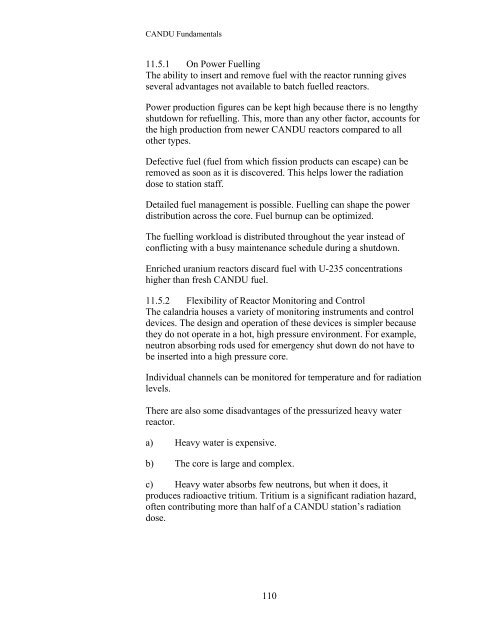11 Candu Reactor Construction
11 Candu Reactor Construction
11 Candu Reactor Construction
Create successful ePaper yourself
Turn your PDF publications into a flip-book with our unique Google optimized e-Paper software.
CANDU Fundamentals<br />
<strong>11</strong>.5.1 On Power Fuelling<br />
The ability to insert and remove fuel with the reactor running gives<br />
several advantages not available to batch fuelled reactors.<br />
Power production figures can be kept high because there is no lengthy<br />
shutdown for refuelling. This, more than any other factor, accounts for<br />
the high production from newer CANDU reactors compared to all<br />
other types.<br />
Defective fuel (fuel from which fission products can escape) can be<br />
removed as soon as it is discovered. This helps lower the radiation<br />
dose to station staff.<br />
Detailed fuel management is possible. Fuelling can shape the power<br />
distribution across the core. Fuel burnup can be optimized.<br />
The fuelling workload is distributed throughout the year instead of<br />
conflicting with a busy maintenance schedule during a shutdown.<br />
Enriched uranium reactors discard fuel with U-235 concentrations<br />
higher than fresh CANDU fuel.<br />
<strong>11</strong>.5.2 Flexibility of <strong>Reactor</strong> Monitoring and Control<br />
The calandria houses a variety of monitoring instruments and control<br />
devices. The design and operation of these devices is simpler because<br />
they do not operate in a hot, high pressure environment. For example,<br />
neutron absorbing rods used for emergency shut down do not have to<br />
be inserted into a high pressure core.<br />
Individual channels can be monitored for temperature and for radiation<br />
levels.<br />
There are also some disadvantages of the pressurized heavy water<br />
reactor.<br />
a) Heavy water is expensive.<br />
b) The core is large and complex.<br />
c) Heavy water absorbs few neutrons, but when it does, it<br />
produces radioactive tritium. Tritium is a significant radiation hazard,<br />
often contributing more than half of a CANDU station’s radiation<br />
dose.<br />
<strong>11</strong>0
















